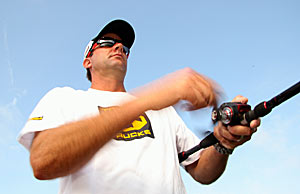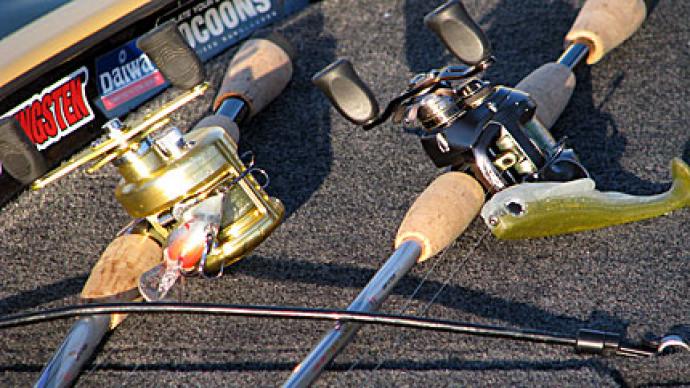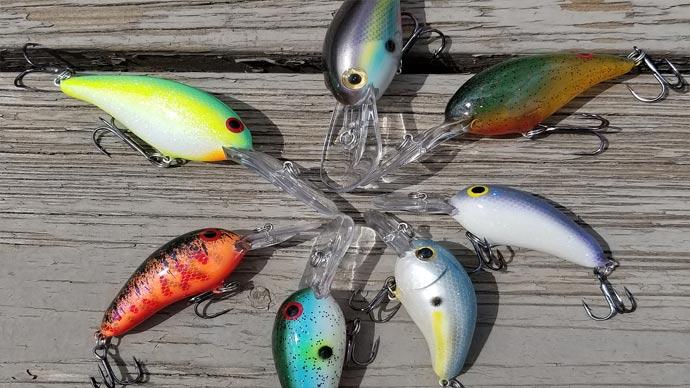
“Slow it down. Don’t reel so fast. You’ll get a lot more bites. This water is really stained,” emphasized VanDam to a weekend warrior along for a day of summer fishing as a guest to the astonishing 7-time Toyota Tundra Bassmaster Angler of the Year. Hugely insightful advice from bass fishing’s most dominant gun meant to rifle home a message as to how critical ‘speed of retrieve’ is to his success.
Throughout Kevin’s years as a pro, the one adjective most often used to describe his fishing style is ‘fast.’ Yet, here he was coaching caution on the throttle of his guest’s baitcaster on a day when the bass’ metabolism was peeked to pursue and catch any prey in the lake.
The water was heavily stained with a summer plankton bloom. To Kevin, that indicated lures would be more difficult for the bass to see through the bloom, warranting the need to slow down the revolutions on the handle of his new Quantum Tour KVD Cranking Classic.
That’s the essence of KVD. He consistently processes information faster than all others. Then he couples mental data with superior mechanical know-how to make those around him feel like they missed the boat. Mechanically, speed of retrieve is more a factor in VanDam’s dominance than how fast he casts or operates his MotorGuide.
Kevin’s mechanical approach to his reel’s retrieve speed is systematic. Much like a NASCAR crew chief specifies detailed motor set-ups depending on the track, VanDam matches reel ratios to lures and presentations. “If I’m pitching to shallow cover, dragging a Carolina Rig or working a topwater, I’ll use a fast reel with the Burner 7.3:1 gear ratio,” said VanDam. “The Burner gear is great anytime the fishing technique requires the rod to do most of the work,” emphasized VanDam, a self-admitted fan of NASCAR, no surprise.
“I use the mid-range 6.6:1 gear ratio for spinnerbaits around shallow cover, as well as for lipless crankbaits in clear water. That gear ratio is a great blend of speed and power,” added Kevin, who has won at least a million bucks on those two lures alone.
Then comes the moneymaker -- ironically, the slowest among the bunch -- the 5.3:1 gear ratio housed in the TKVD150PPT he’s used to crank up his most recent Angler of the Year and Bassmaster Classic victories. A gear ratio so loved by VanDam he asked Quantum to make a newer, lighter, special ‘Cranking Classic’ edition reel featuring that specific gear ratio.
“The 5.3:1 is the ratio I use for all crankbait fishing,” VanDam made clear. “From shallow squarebills to a deep diving 6XD from Strike King, the 5.3:1 gives you smoothness and power with less torque. Because there’s less torque, you have the ability to feel what the bait is doing at all times. Feel is hugely important in crankbait fishing. You have to be able to feel a piece of hydrilla that’s hung on your treble hook, or a subtle bite in deep water. You just don’t get that detailed level of feel with a higher-speed reel,” he emphasizes.
Beyond Kevin’s systematic approach of matching lures to gear ratios is his supernatural ability to analyze and act upon the natural variables all anglers must consider, such as water temperature. And as was the case on this day of instruction -- water clarity.
“This past year’s Classic in New Orleans was a great example of how critical speed of retrieve is,” illustrated VanDam. “The first day, the water temp was 52 and they wanted a spinnerbait slowly crawled around the stumps, but as the water warmed to 57, they wanted a squarebill bounced off the stumps fairly fast and erratic. I was using a slower gear ratio when cranking than what my 6.6:1 spinnerbait reel features, but when crankbaiting you need to consider that the 5.3:1 reel is coupled with Quantum’s 150-size spool and picking up 23-inches of line every time you turn the handle. When you’re winding it quickly in shallow water like I was in New Orleans, it created a fast erratic action, but I still had tons of feel with the 5.3:1.”
In conclusion, VanDam offered simple advice for all anglers confused about the correct speed of retrieve. “I always start slower when I’m trying to figure them out, and match reel ratios to the technique or lure. But you should always start slower, and speed up from there if the fish will allow you to.” That’s ironic and eye-opening advice from a guy whose reputation is that of the fastest angler on tour.




